Campeche City
San Francisco de Campeche[1] (pronounced [sam fɾanˈsisko ðe kamˈpe.tʃe]; Yucatec Maya: Ahk'ìin Pech, pronounced [aχkʼiːn˥˧ pʰetʃ]), 19th c. English also Campeachy,[2] is a city in Campeche Municipality in the state of Campeche, Mexico on the shore of the Bay of Campeche of the Gulf of Mexico. Both the seat of the municipality and the state's capital, the city had a population at the 2010 census of 220,389,[3] and the municipality had a population of 259,005.[3]
San Francisco de Campeche | |
|---|---|
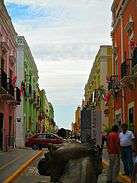   Photomontage of Campeche City | |
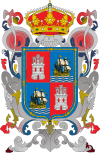 Coat of arms | |
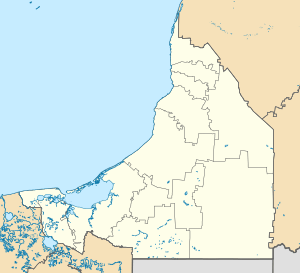 San Francisco de Campeche  San Francisco de Campeche | |
| Coordinates: 19°51′0″N 90°31′50″W | |
| Country | Mexico |
| State | Campeche |
| Municipality | Campeche |
| City Founded | October 4, 1540 (480 years ago) |
| Government | |
| • Mayor | Eliseo Fernández Montufar (2018–2021) |
| Elevation | 10 m (33 ft) |
| Population (2010) | |
| • Total | 220,389 |
| Demonym(s) | Campechano |
| Time zone | UTC−6 (Central (US Central)) |
| • Summer (DST) | UTC−5 (Central) |
| Area code(s) | 981 |
| Major Airport | Ing. Alberto Acuña Ongay International Airport |
| IATA Code | CPE |
| ICAO Code | MMCP |
| Website | Official Campeche Website |
| Official name | Historic Fortified Town of Campeche |
| Type | Cultural |
| Criteria | ii, iv |
| Designated | 1999 (23rd session) |
| Reference no. | 895 |
| State Party | |
| Region | Latin America and the Caribbean |
The city was founded in 1540 by Spanish conquistadores as San Francisco de Campeche atop the pre-existing Maya city of Can Pech. The Pre-Columbian city was described as having 3,000 houses and various monuments, of which little trace remains.
The city retains many of the old colonial Spanish city walls and fortifications which protected the city (not always successfully) from pirates and buccaneers. The state of preservation and quality of its architecture earned it the status of a UNESCO World Heritage Site in 1999. Originally, the Spaniards lived inside the walled city, while the natives lived in the surrounding barrios of San Francisco, Guadalupe and San Román. These barrios still retain their original churches; the one in Guadalupe is almost 500 years old.
History
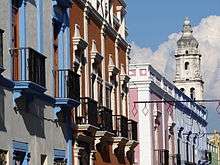
Founded in 1540 by Francisco Montejo, Campeche was terrorized by pirates and marauders until the city started fortification in 1686.[4]
San Francisco de Campeche was originally an indigenous village, Ah Kim Pech, where the Spanish first landed in Mexico in 1517. The city of Campeche was founded in 1540 and fortified against pirates during the 17th century. It still has the appearance of a fortress. Historical monuments and buildings, such as the Franciscan cathedral, old Maya ruins, and the old city walls and forts, attract many tourists.
The fortifications system of Campeche, an eminent example of the military architecture of the 17th and 18th centuries, is part of an overall defensive system set up by the Spanish to protect the ports on the Caribbean Sea from pirate attacks like the 1663 Sack of Campeche.
The state of preservation and quality of its architecture earned it the status of a World Heritage Site in 1999.[5][6]
First expeditions
The first expedition of the Spaniards that touched the coasts of Campeche was commanded by Francisco Hernández de Córdoba in 1517. he left the island of Cuba on February 8, touched Isla Mujeres and Cabo Catoche the first days of March, continued to pay for the peninsula and arrived in Campeche on Sunday of San Lázaro March 22, 1517, which is why Hernández de Córdoba baptized the place with that name. The natives of Campeche welcomed the Spaniards and touched their beards and their people.
The chronicle of Bernal Díaz del Castillo narrates that a few days later they sighted a village planted on the coast, landed cautiously and set foot on land they discovered "Can Pech".[7] This took place on Sunday March 22, 1517. In need of water, the Spaniards landed with the help of bats and supplied themselves in a well. As the Mayans approached, the Spaniards indicated by means of signs that they came in peace; the chief of the region asked them if they came from where the sun rises, mentioning the word "castilán". The Spaniards, surprised at this word, responded affirmatively, and Cacique invited them to his population, where copal was lit. By means of signs, the "halach uinik" indicated to the expeditionaries that they should leave the place before the fire went out. Meanwhile, warriors were arriving at the place. From the experience of Cabo Catoche, the Spanish preferred to leave. (They would be surprised by a "north" wind and with the rough sea, they would lose the water supplied, having to land again for their bad luck in Chakán Putum where the strongest battle between Mayans and Spaniards would take place.)
Conquest
After the conquest of Tenochtitlan, Francisco de Montejo traveled to Spain, where he requested Carlos V permission to conquer the Yucatan Peninsula. In 1526, the Spanish crown granted Montejo the title of "Adelantado, governor, sheriff and captain general of Yucatan". The conquests of Champotón and Campeche, were part of the Conquest of Yucatan, which was carried out in three stages.
In the first stage (1527 to 1529), Montejo ventured along the eastern coast of the peninsula with the help of the captain Alonso Dávila, whom he had known since Cortes' expedition, but they were repelled by the Maya.
In the second stage (1530-1535), Montejo ventured into the west, and managed to found "Salamanca de Campeche" in 1531. Alonso Dávila was sent by Montejo to cross the peninsula south and founded Villa Real in Bacalar, but this position had to be abandoned.
Montejo's son known as Montejo "el Mozo" is defeated in the royal city of Chichén Itzá towards the end of 1534, so in 1535 the Spaniards leave the peninsula for five years.
Towards 1540, "the Adelantado" assigned Lorenzo de Godoy to install the first garrison in San Pedro de Champotón, which they maintained with many difficulties, since they did not have people or soldiers. Montejo "the Nephew" helped keep the garrison and changed its name to "Salamanca de Champotón". "The Adelantado" arrived in Ciudad Real de Chiapa (San Cristóbal de las Casas), in 1540, and from there he gave instructions to Francisco Gil to be in charge of Champotón's position and thus "El Mozo" and "the Nephew" would begin the advance north. In 1546, when the conquest of Yucatan seemed to be over, "the Adelantado" and his wife traveled to San Francisco de Campeche to meet with his son "El Mozo" and "El Nephew". The Maya had organized in secret, and on the night of November 8 to 9 (5 Cimi 19 Xul, death and end of the Mayan calendar) a great rebellion broke out. "El Mozo" and "el Sobrino" would once again take up arms to "reconquer" the peninsula and submit the rebellions a year later.[8]
Viceroyalty period
The town of that time was built around a square occupied solely by the pillory, a column that served as a symbol of power and Spanish justice. Around the square the parish of Our Lady of the Purest Conception, the Audience and the houses of the highest-ranking conquerors were built. The market would be built around a smaller plaza and commercial life developed. The jail, the Municipal Palace and the defense tower against the fireworks would be built soon after.
The villa founded by the Spaniards was somewhat removed from the locality Mayan people. The Spaniards made their life around the square, in the current neighborhood of San Román, while the natives were added in the old pre-Hispanic settlements, currently the neighborhoods of San Francisco and Siete de Agosto. The Naboríos, indigenous Mexicans who arrived with the conquerors, occupied the San Román neighborhood and the population of slaves from Africa the neighborhoods of Santa Ana and Santa Lucía.
Maritime trade conditioned the development of the town, so it was designed with a Renaissance model: a regular trace in checkerboard around an eccentric square that, according to the ordinances of the Spanish Crown, should serve for parties and ceremonies, oriented around its bay.[9]
Once established Francisco de Montejo y León "el Mozo" in the town, the city became the base of operations for the conquest of the rest of Yucatán (1542 - 1546) which led to the occupation of Ichkanzihóo (Th'o), the old city of the Itzáes. then abandoned, where the provincial capital was founded, Mérida in 1542.
The "armed" conquest was followed by the ideological "conquest, which consisted of the implantation of European doctrinal beliefs, particularly that of the Catholic religion. The first religious order that He arrived in Campeche was that of the Franciscan s, who arrived in Campeche in 1535, but had to retire due to a series of difficulties raised by both indigenous and Spanish people, to return five years after that Montejo was established in Campeche, in 1540. Upon his return, they began the construction of a temple and convent dedicated to San Francisco close to the population Maya, its founder was Fray Luis de Villalpando.
The evangelization was similar throughout New Spain, the Franciscans had no more difficulty once the language barrier was overcome, and they were the only order that carried out this task in the province of San José, which It was how the Yucatan Peninsula was named. The evangelists had to overcome certain difficulties, such as the differences of a community culture, such as that of the natives.
In 1542, the king proclaimed the calls New Laws, which established the freedom of the Indians as subjects of the Crown. Slavery was legally abolished, but would continue by other means. The parcel subject a certain number of peoples to a Spaniard, to whom they had to pay in kind (wax, cotton blankets) and labor. Those who were not entrusted were under the royal jurisdiction and received the name of "peoples of the Royal Crown." The indigenous tributaries of the encomiendas español, continued to suffer a treatment that was practically slavery. The friars of the different religious orders present fought to defend the rights of the indigenous people, preserve their freedom and limit the abuses of the conquerors. Thanks to this, in 1547, Felipe II of Spain issued a royal identity card in favor of the personal freedom of the natives, and to make sure that their interests were fulfilled, he created a City Hall Mayor for the province of Yucatán.[10]
Trade and piracy
Campeche's position in the Gulf of Mexico made it the main port of the Yucatan Peninsula, standing out as a point of connection with the foreigner, which allowed the economic boom and population growth. From there, from early times, the cargoes of the so-called palo de Campeche, also known as "dye stick", a native product of the region that would lead to large estates, among which are counted, Uayamón, Xanabchakán and Mucuychacán, to mention three of them, and also of salt. The port of Campeche also gained fame for its Shipyards industry.
The commercial monopoly of Spain, implemented by the House of Hiring of the Indies to their domains, which prohibited them from trading even among themselves and with other nations, led to illegal practices such as piracy. One of the measures to stop them was promulgated in 1616 by the Mayor of Yucatan Luis de Céspedes y Oviedo, which involved the creation of a license on the cutting and trade of the Campeche stick, as well Like new taxes. This first measure was insufficient and counterproductive, because far from bringing down piracy, he encouraged it. In 1629, the King of Spain Felipe IV created a navy coast guard to protect trade, but this measure also did not give the expected results, neither did the military garrison to protect the city implanted by Mayor Centeno Maldonado. The constant pressures from other European nations and the continuing uprisings in their Dutch positions made it impossible to adopt new measures against piracy, which remained in full swing.[11]
Among the pirates most famous that docked at Campeche are John Hawkins, Francis Drake, Laurens de Graaf, Cornelius Jol, Jacobo Jackson, Michel de Grandmont, Portuguese Bartholomew, William Parker, Jean David Nau, Edward Mansvelt, Henry Morgan, Lewis Scot, Roche Brasiliano and Jean Lafitte. On January 27, 1661, a fleet of filibusters appeared in the port of San Francisco de Campeche and, although it did not disembark, looted two well-loaded commercial frigates, which barely arrived and then quietly withdrew, without being chased, because that day there was no armed ship in the bay capable of hunting him. The head of this filibuster expedition was called Henry Morgan.
A very feared pirate in the town of Campeche was Laurens de Graaf or Lorencillo, who was Dutch and had served the king of Spain fighting filibusters. But then he also dedicated himself to piracy. In 1685 he attacked and took the town of Campeche and twenty other towns in the area. He spent two months and captured so many prisoners and stole so many jewels and pieces of silver that filled the cargo of his ship. He was chased by three Spanish frigates with cannons. The pirate dodged the attacks, threw the entire load into the sea so that the ship achieved greater speed and, with wind in favor, moved away quickly.
Another pirate was El Olonés whose real name was Jean David Nau. He committed innumerable and famous stumbling against the Spanish viceroyalty of the mainland. In a terrible storm, he lost his ship on the coast of Campeche. All the men were saved, but, arriving on land, the Spanish persecuted them by killing most of them, and also hurting the Olonés. Not knowing this how to escape, he thought about saving his life through a ploy: he took several handfuls of sand and mixing it with the blood of his own wounds he smeared his face and other parts of his body. Then, hiding with great skill among the dead, he remained motionless until the Spaniards left the field of struggle. Since they were gone, he retired to the forest, sold his wounds and took care of them until heal and then headed to the City of Campeche perfectly disguised. In the city, he spoke with certain slaves to whom he promised freedom in case they obeyed him. They accepted their promises and stealing a canoe at night, threw themselves into the sea with the Olonés.
Elevation to City rank
The coat of arms held by the city of San Francisco de Campeche was granted in 1777 by the king of Spain Carlos III,[12] being elevated from the title of villa to that of city.
Before the current shield was adopted, there was a process to constitute a shield as an officer. The first project was presented in 1772 before the possible elevation to the title of city of the town of San Francisco de Campeche, when requested by the Cabildo de Campeche in a contest for the election of shield de Armas.[13] The first design was submitted by Juan Antonio Rexo and Peñuelas on September 24 of that year but was rejected on October 17 for not being subject to the rules of heraldry. Ramón Zazo and Ortega subsequently presented three projects; the first two were rejected but finally the third was approved in council council on November 7, 1777. The shield was approved by his majesty Carlos III of Spain with the certificate of: "the City Title is granted to the town of San Francisco de Campeche."
Economy
The economy of San Francisco de Campeche is based primarily on the services sector: commerce, tourism, communications, public administration, public services. There are also various maquiladora s textiles installed in the city, and small and medium-sized enterprises generally associated with the exploitation of primary products, forming the secondary sector. The primary sector persists through fishing activity.
Tourism
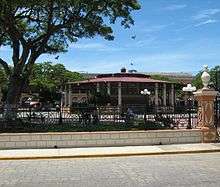
In recent years tourism has had a strong boost in the State of Campeche. Underpinning the tourist activity the emblematic places in the capital city are:
Downtown and historic neighborhoods
With an excellent state of preservation, the City of San Francisco de Campeche, in the viceroy style baroque, is a beautiful example of a fortified urban center. This quality has earned him a title of Cultural Heritage of Humanity by the United Nations Educational, Scientific and Cultural Organization.
Its aligned streets allow us to take a tour admiring the decoration of its houses, some of them with strong Moorish and Spanish reminiscences of the 18th century and some modifications of the 19th century. The color of its facades print a vibrant sense of life in those who visit them, each street is full of stories and legends.
The walls around part of the city are a reminder of the viceroyalty of the 17th and 18th centuries.
Religious and civil architecture are merged with civil and military architecture, as modest bastions of faith that protected the population during pirate offensives; Franciscan bulrush churches and baroque altarpieces with Solomon columns leave a mark of their strong impact during Catholic evangelization in fortified American lands such as the Villa de San Francisco de Campeche. The sobriety of its facades are imposed on the faith when the protection of its faithful was pondering.
Archaeological sites
There is the place known as Acanmul and also relatively close, the archaeological sites of Edzná and Jaina. The city can also be taken as a starting point to visit other important sites of the State of Campeche.
Edzná
The "Casa de los Itzáes", is a place where we find about twenty monumental buildings that tell us about the concentration of political, economic and religious power that occurred in pre-Columbian times.
Due to the type of soil, the valley in which it is located, is flooded in the rainy season and retains high humidity almost all year. To remedy this problem, the Maya developed an advanced system of hydraulic works: a network of canals drained the valley and the water was taken to a lagoon, which was transformed into dam through retaining walls, while other canals were used to irrigate the fields. This led to an optimum degree of moisture in the soil for intensive cultivation while the canals provided abundant fishing, and were used as communication routes and in some cases served as a defense. The plazas had a magnificent drain system and the rainwater reached artificial reservoirs called chultunes.
Edzná had numerous religious, administrative and residential buildings distributed over an area of approximately 25 square kilometers. Of particular importance on this site is the five-story building, which is built on a large platform that gives it great architectural majesty.
Jaina
The "House on the sea" is one of the most interesting places in the region due mainly to its fame as a Mayan necropolis. A little more than a thousand human burials have been explored around the site, in which extraordinary pieces of clay have been found that were possibly deposited as mortuary offerings. At the time of their discovery, these pieces helped cultivate a new appreciation of the art Mayan Culture made in mud, since its quality far exceeded what had previously been found in the area.
The Petenes
Part of the urban area of San Francisco de Campeche borders the Los Petenes Biosphere Reserve.
Curious circular forms of vegetation have been called petenes where the origin of a source of fresh water, in the middle of an area of salt water, promotes the development of plants less resistant to salt, leading to islets where flora has taken hierarchy around the origin of fresh water. It is an entire organization that allows nesting and refuge for a large number of bird and mammal species.
In the coastal mangroves of the reserve, there are innumerable natural paths that make up attractive routes, in them the sport of fishing tarpon and the observation of birds and other animal species are carried out.
The enormous natural wealth of the area, forms the ideal scenario for the development and enjoyment of various activities ecotourism.
Culture
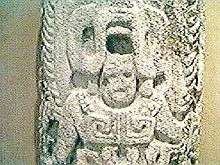
The typical dress
Essentially composed of three pieces, the upper part has its origin in the huipil or mestizo hipil, it differs in that it is embroidered in black and with motifs inspired by the flowers of onion and pumpkin. The suit complements an overflow of Santa Maria; The skirt is of Spanish origin and reaches the ankles is made of calico or zaraza, fine printed taffeta or Spanish brocade.
Music and dances
Campechanos like musical notes in all their forms, from romantic songs to cheerful serenades.
- 'Los pregones.' Estampas costumbristas, which represent, in a very special way, several typical Campeche characters, offering merchandise that they sell in different neighborhoods and streets.
- 'Las chancletitas.' The agile chacleteo.
- 'The shaking.' He is the forerunner of the Loving Pichito and other zarandangas, written in 2/4 compass of live and martial movement. Keep kinship with sounds of Mayan influence.
- 'The cutz.' It is a turkey of beautiful plumage. According to legend, when the birds of these rainforests did their parties and danced, there was no mount turkey, which was dispossessed by nature, of its feathers. Until he was discovered by the pheasant, who invited him to the celebration, and to wrap him up, each of the attendees gave him a feather of his kind. Thus he acquired his splendid plumage. But looking so beautiful, he did not want to lose his wardrobe and fled. The pujuy, (cover roads) looks for him, stopping the flight of all the birds and in his song he says: give me back my suit, gentleman! The dancers symbolize the feathers with a ribbon of color that each one brings, and on the neck of the dancer representing the cutz, they turn them on.
- 'Jarana 6x8.' Emerging with a history of the "first dairy", it is currently in the public domain; This version does not have more than forty years of dancing in Campeche. They combine their cheerful rhythm with a "'Guapacheo".
- 'El Gallo.' It is an indigenous dance characteristic of the town of Lerma. It is danced on May 3, at the feast of the Holy Cross. Its purpose is to attract fertility in the fields, so they sacrifice a rooster that during the dance takes it hanging on the back, the only man who participates in it. The women are holding a jícara with corn seeds that sound like the movement of the dance steps. It is customary to wear a hat on which they place a paliacate.
- 'Son del turkey.' (Seguidilla) is a short-lived zapateado, but very energetic and vivacious. It became widespread in the mid-19th century. They dance in pairs, caught by one arm of the waist, while the other is free and raised. The dance is characterized by its agility and joy.
- 'La Guaranducha.' Jarana 6x8 and Habanera. You can start can jarana, but with the special mode of the tropics in the guapacheos and zapateados. Halfway through the dance, the Havana rhythm corresponding to the black influence troupe is introduced; At this time, the couples of ease come off to dance, while they chant and mark the rhythm with claps. In the end, everyone joins the dance, ending with the jarana.
- 'Creole syrup.' The rattling of three churches of the port of Campeche calling for worship inspired the composition of this syrup. This syrup is one of the oldest that has news in Mexico.
- 'Pichito amoroso.' It belongs to the big genus and is a Zarabanda with which the "Santaneros" began. It is one of the most cheerful tropical rhythm dances with the youthful bullanguera of Campeche. Can the arms imitates the flight of this bird that belongs to the group of thrush, so its jumps and jumps give rise to complicated figures and accompanied and beautiful auctions.
- 'La Jerengoza.' Dance typical of the region that coincides with Las Randeñas, known tonadilla in the neighborhood of Santa Ana; their music is lively and strident and the dancers, with redoubled step, take wheel positions and turn making changes towards the center and outwards, or on themselves, to finish with a very colorful finish.
- 'The cockroach.' Dance known as "are of trouble", its execution requires ease and grace, since its rhythm coincides with those of "choteo", "correteo" and "bailoteo", when interpreting it, the man puts his hands on the woman's shoulders, leaning a little towards her, thus imitating the cockroach shell.
- 'Campechito retrechero.' Jarana that is danced to the rhythm of six by eight; of agile zapateado, where the dancers show their grace and dexterity and, as proof of this, either in the bushel or on the table, a bottle is placed on the head, and some of them, trays with glasses and bottles, same, that despite the zapateado, when performing the dance, they remain keeping a balance that causes admiration.
- 'The flower of the malagueña.' This number belongs to the great survival sounds in Campeche, its genre is dotted Malagueña. It is considered as one of the oldest. It is singled out by the cadence with solos that led to unusual dance poses, with very airy and light movements. Its structure is markedly Spanish.
- 'Creole syrup.' His dance dates back to the end of the 18th century and is also a strong number, has diverse choreographies and some quite complicated, but the theme is in the reproduction that the dancers do together with the Charanga, of the so-called bells of the Cathedral, its end is large and studied.
- 'Campechanita Habanera.' This dance is a classic Havana or Cuban chain. It goes back to the year of 1861 and was danced in all the salons of the time; The dance opens with the salt shaker that characterizes the campechanos and concludes with a zapateado to finish off.
- 'Syrup Gatuno.' Piece considered to be large classic, is a cat; its importance is that only in Campeche survives in its three versions, because it was condemned to disappear for not agreeing to the customs of its time.
- 'The Fandango.' They are large classic, based in Campeche, since the 18th century, and is still in some regions. Because of its idea of disorder and hustle and bustle, it is interpreted in very lively and cheerful ways without making a couple or defining with whom you dance, all dance and zap in confusion, marking and challenging with heel strokes who is closest indifferent to the opposite sex. It retains the Spanish style very marked, it is written in three-beat measure and there is no news of its copla.
- 'Cuban Arabic.' This is a short but very energetic dance, it is written in six eighths and its genre is zapateado. It is danced linked by the waist and with the free hand up, it is always done in the game of two couples or in even numbers that evolve, heel and valsean with very fast turns and running almost the entire stage, it is repeated several times, it concludes with a strong blow and displace the public, asking for applause.
- 'Campechito retrechero.' It is the diminutive affectionate together with the traditional expression that means the contagious joy and the carefree limitlessness of the Campeche spirit, given name to this typical jarana. The dancers embellish themselves with their heels and infect the spectator, with the bullanguera chant of an ancient town that has managed to project a personality across seas and continents.
- 'Baile del Almud.' Set of mestizo sounds that naturalized in Yucatán and Campeche, acquired the name of jarana; The skillful heel and shot at 6x8 pace make it very lucid. When running on a bushel, its beauty becomes more significant, when the music is interrupted, the dancers continue to zap, taking turns in this fate, and demonstrating their ability.
Gastronomy
Gastronomy is one of the best in Mexico. Remembering the "Cruise Poet" Yucatecan, Campeche's deep admirer:
"Two things have Campeche that cause admiration: His pickled branch ... And his rich Cazón Bread."
Among its dishes is the seafood cocktail, pickled fish, and Cazón bread. Other dishes include the Sierra Frita, the Pámpano in Verde, as well as appetizers from region such as panuchos and tamales coladas, among others.
- Pan de cazón: a stacked, casserole dish consisting of tortillas, beans and dogfish with a tomato-based habanero sauce.
- Cazón empanadas
- Aguas frescas: (horchata, Jamaica, black tea)
- Coconut shrimp
- Green branch
'Cocktail invention.' Upon arrival at the port of Campeche, the English merchants of precious woods drank in the taverns wines and unmixed liquors called "dracs" of rum or other alcohol and stirred them with a metal spoon or a toothpick, on one occasion, the bartender used thin, thin, smooth roots of a plant that they called "cocktail", in English cock's tail from now on they would ask no longer for "dracs" but cocktails.
Fairs and cultural events
- Bread Fair: In the month of March
- Carnival: it is celebrated in the month of February without a definite date, for more than 450 years. The oldest carnival in the country begins with the funeral walk and the burning of bad mood, represented by a rag doll.[14]
- San Román Fair: from September 14 to 30. It begins with the descent of the Black Christ from the Church of the homonymous neighborhood.
- San Francisco Fair: held from October 4 to 19.
- International Cervantino Festival.
- Cultural Festival of the historic center: it takes place in December
- Expoindustrial
Press
- Tribuna de Campeche
- Novedades de Campeche
- Crónica de Campeche
- El Sur de Campeche
- El Expreso de Campeche
- Campeche Hoy
- La N de Campeche
- Semanario Horizonte
- La Opinión
- Por Esto!
Television
- XHCAM-TDT ...24 ( 7.1 HD ) - Azteca 7
- 24 (7.2 SD) - a+
- XHCTCA-TDT 20 ( 3.1 HD ) - Imagen Televisión
- 20 (3.4 SD) - Excélsior TV
- XHAN-TDT 22 (5.1 HD) - Canal 5
- 22 (9.1 SD) - NU9VE (Televisa Campeche)
- XHTMCA-TDT 27 (13.1) Telsusa Television
- XHGE-TDT 29 ( 1.1 HD ) - Azteca 13
- 29 ( 1.2 SD ) - ADN 40
- XHCCA-TDT 30 (4.1 HD) - Televisión y Radio de Campeche
- XHOPCC-TDT 32 (14.1 HD) - Canal Catorce
- 32 (11.1 SD) - Canal Once
- 32 (22.1 SD) - Canal 22
- 32 (14.2 SD) - Ingenio Tv
- 32 (20.1 SD) - TV UNAM
- 32 (45.1 SD) - Canal del Congreso
- XHCPA-TDT 34 (2.1 HD) - Las Estrellas
Pay TV
- Telemar
- Telesur
- Mayavisión
- TVM
City fortifications
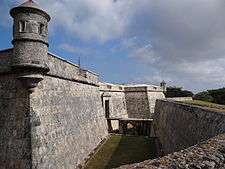
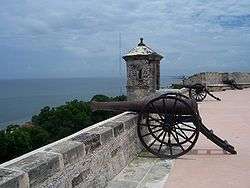
The city of Campeche is an example of urbanism in a baroque colonial city, with a reticular and regular plan, its urban trace, a model of colonial port cities, reflects the main role that it played as a commercial, religious and military connection point characterized by its high level of integrity and homogeneity. More than one thousand buildings with a historic value have survived as witnesses of space and temporal superimposition of several significant historic periods of Mexico.
Due to the constant attacks of both English and Dutch buccaneers and pirates such as Francis Drake, John Hawkins, Laurens de Graaf, Cornelis Jol, Jacobo Jackson, Jean Lafitte, Francisco de Grammont, Bartolomé Portugués, William Parker, Francisco Nau, Edward Mansvelt, Henry Morgan, Lewis Scot, Roche Braziliano and Michel de Grammont for almost 160 years, in 1686 the government started to fortify the city.[4]
The French engineer Louis Bouchard de Becour was commissioned to unify all the defensive works that surrounded the city with a wall. At its completion, the wall surrounding the city of Campeche was 2,560 meters in length, forming an irregular hexagon around the main part of the city, with eight defensive bastions on the corners. These bulwarks now serve different functions:
- Santiago: Used as the Botanical Garden 'Xmuch´haltún'. Reconstructed.
- San Pedro: Former prison.
- San Francisco: Protects the Land Gate. Houses the library of the INAH.
- San Juan: Protects the Land Gate.
- Nuestra Señora de la Soledad: Also protects the Sea Gate. It is the largest one and holds the Museum of City History.
- San Carlos: Holds the City Museum. This fort was the first one built. Protects the Sea Gate.
- Santa Rosa.
It also contained four gates to allow access to the main quarters. The main entrances are the Puerta de la tierra ("Land Gate"), built in 1732, and the Puerta del mar ("Sea Gate"). The Land Gate is kept as a tourist attraction, having a light and sound show three nights each week and keeping original supplies and items from the 17th century. The other gates were Guadalupe and San Román, connecting to the outside neighborhoods.
Additionally, two main forts protected the city from two nearby hills on each side, the forts of San José el Alto (built in 1762) and San Miguel. These forts gave long-range artillery coverage and served also as look-outs. They were built before the walls of the city. The fort of San Miguel is used as a museum and houses a collection of pre-Hispanic items. The fort of San José houses a collection of boats and weapons of the period.
Demographics
As of 2010, the municipality had a total population of 259,005.[3]
The municipal seat, and largest settlement, is the city of San Francisco de Campeche (often shortened to Campeche). As of 2010, the city had a population of 220,389.[3]
Aside from the municipal seat, the municipality has 564 localities.
The largest localities are, (with 2010 populations in parentheses): Lerma (8,281), Chiná (5,194), classified as urban, and Los Laureles (2,251), Alfredo V. Bonfil (2,060), Pich (1,756), Tikinmul (1,663), Imí (1,227), Hampolol (1,123), Castamay (1,101), and San Francisco Kobén (1,045), classified as rural.[3]
Twin towns – sister cities

.svg.png)



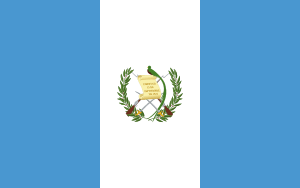

Climate
Campeche has a tropical savanna climate, with most rain falling in the wet season from June to October.
| Climate data for Campeche (1951–2010) | |||||||||||||
|---|---|---|---|---|---|---|---|---|---|---|---|---|---|
| Month | Jan | Feb | Mar | Apr | May | Jun | Jul | Aug | Sep | Oct | Nov | Dec | Year |
| Record high °C (°F) | 38.8 (101.8) |
39.0 (102.2) |
41.0 (105.8) |
44.0 (111.2) |
45.0 (113.0) |
43.0 (109.4) |
40.0 (104.0) |
40.0 (104.0) |
39.0 (102.2) |
40.5 (104.9) |
38.0 (100.4) |
40.0 (104.0) |
45.0 (113.0) |
| Average high °C (°F) | 29.1 (84.4) |
30.6 (87.1) |
32.7 (90.9) |
35.0 (95.0) |
35.9 (96.6) |
34.9 (94.8) |
34.5 (94.1) |
34.2 (93.6) |
33.4 (92.1) |
32.1 (89.8) |
30.7 (87.3) |
29.4 (84.9) |
32.7 (90.9) |
| Daily mean °C (°F) | 23.7 (74.7) |
24.7 (76.5) |
26.5 (79.7) |
28.5 (83.3) |
29.6 (85.3) |
29.2 (84.6) |
28.7 (83.7) |
28.5 (83.3) |
28.2 (82.8) |
27.0 (80.6) |
25.4 (77.7) |
24.0 (75.2) |
27.0 (80.6) |
| Average low °C (°F) | 18.2 (64.8) |
18.7 (65.7) |
20.2 (68.4) |
22.1 (71.8) |
23.4 (74.1) |
23.5 (74.3) |
22.9 (73.2) |
22.7 (72.9) |
22.9 (73.2) |
21.9 (71.4) |
20.0 (68.0) |
18.6 (65.5) |
21.3 (70.3) |
| Record low °C (°F) | 8.0 (46.4) |
9.0 (48.2) |
10.0 (50.0) |
13.0 (55.4) |
16.0 (60.8) |
17.0 (62.6) |
18.0 (64.4) |
19.0 (66.2) |
18.0 (64.4) |
15.0 (59.0) |
12.0 (53.6) |
9.0 (48.2) |
8.0 (46.4) |
| Average precipitation mm (inches) | 25.8 (1.02) |
15.8 (0.62) |
12.4 (0.49) |
13.0 (0.51) |
53.9 (2.12) |
162.0 (6.38) |
181.3 (7.14) |
188.2 (7.41) |
203.1 (8.00) |
117.9 (4.64) |
41.0 (1.61) |
25.0 (0.98) |
1,039.4 (40.92) |
| Average precipitation days (≥ 0.1 mm) | 3.9 | 2.5 | 2.0 | 1.3 | 3.9 | 11.7 | 14.8 | 14.6 | 14.3 | 9.3 | 4.7 | 3.5 | 86.5 |
| Average relative humidity (%) | 74 | 71 | 68 | 66 | 64 | 68 | 74 | 76 | 78 | 77 | 77 | 75 | 72 |
| Mean monthly sunshine hours | 216 | 200 | 264 | 267 | 254 | 237 | 241 | 236 | 202 | 208 | 194 | 177 | 2,696 |
| Source 1: Servicio Meteorológico National (humidity 1981–2000)[18][19] | |||||||||||||
| Source 2: Deutscher Wetterdienst (sun, 1961–1990)[20][lower-alpha 1] | |||||||||||||
Gallery
- Archaeological zone of Edzná.
- Colonial Spanish houses in Campeche.
 Buildings along a street in central Campeche with typical colors.
Buildings along a street in central Campeche with typical colors.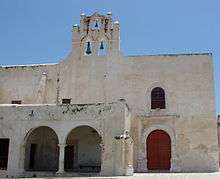
 Campeche fishermen cutting up the catch on the Gulf of Mexico.
Campeche fishermen cutting up the catch on the Gulf of Mexico. Shop in central Campeche selling magical adjuncts and elixirs.
Shop in central Campeche selling magical adjuncts and elixirs. Francisco de Paula Toro Theatre, (1832 - 1834).
Francisco de Paula Toro Theatre, (1832 - 1834). Maya stela at the Fort of San Miguel Museum.
Maya stela at the Fort of San Miguel Museum.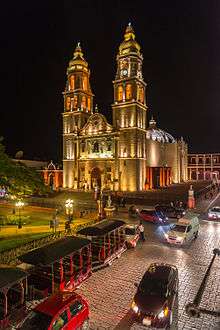 Cathedral of the city.
Cathedral of the city. Jardín Botánico Xmuch' Haltun.
Jardín Botánico Xmuch' Haltun. City of Campeche.
City of Campeche.
Notes
- Link to tables of population data from Census of 2005 INEGI: Instituto Nacional de Estadística, Geografía e Informática
Notes
- Station ID for Campeche, CAMP. is 76695 Use this station ID to locate the sunshine duration
References
- "Constitucion Politica del Estado de Campeche (chapter 10, article 24)" (PDF). Archived from the original (PDF) on July 25, 2011. Retrieved August 24, 2010.
- https://www.google.com/search?q=campeachy&source=lnms&tbm=bks
- "Campeche". Catálogo de Localidades. Secretaría de Desarrollo Social (SEDESOL). Retrieved 23 April 2014.
- Marley, David (2005) Historic cities of the Americas: an illustrated encyclopedia, Volume 1 p.223. ABC-CLIO, 2005
- Centre, UNESCO World Heritage. "Historic Fortified Town of Campeche". whc.unesco.org.
- World Heritage Site - Campeche Archived 2010-08-21 at the Wayback Machine
- "ITESM - Campeche". Archived from the original on April 20, 2009.
- Conquest and Colonization of the Yucatan, Robert S. Chamberlain, Ed. Purrúa 1974
- "Government of Campeche - Conquest and Colonization of Yucatán".
- "CAMPECHE - Ideological conquest".
- "CAMPECHE GOVERNMENT - Commerce and Piracy". Archived from the original on January 22, 2009.
- "Campeche - Symbols".
- "The Mayan World - Campechye Tourism". Archived from the original on December 3, 2008.
- http://www.visitmexico.com/en/carnavales-en-mexico Accessed 6 January 2017.
- "Acuerdos interinstitucionales registrados por dependencias y municipios de Campeche". sre.gob.mx (in Spanish). Secretaría de relaciones exteriores. Retrieved 2020-06-11.
- "Economic partnership with Zhuhai, China" (PDF). halifax.ca. Halifax Regional Council. 2018-06-05. p. 12. Retrieved 2020-06-11.
- "Coffee & Conversation, Sister Cities 1/6". icflorida.com. WFTV. 2018-01-06. Retrieved 2020-06-11.
- "Estado de Campeche–Estacion: Campeche (DGE)". NORMALES CLIMATOLÓGICAS 1951–2010 (in Spanish). Servicio Meteorológico National. Archived from the original on 18 May 2015. Retrieved 7 May 2015.
- "NORMALES CLIMATOLÓGICAS 1981–2000" (PDF) (in Spanish). Servicio Meteorológico Nacional. Archived from the original (PDF) on 25 April 2015. Retrieved 7 May 2015.
- "Station 76695 Campeche, CAMP". Global station data 1961–1990—Sunshine Duration. Deutscher Wetterdienst. Archived from the original on 17 October 2017. Retrieved 7 May 2015.
Bibliography
External links
| Wikisource has the text of the 1911 Encyclopædia Britannica article Campeche (city). |


- Official Campeche website

